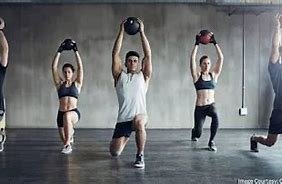Functional training focuses on exercises that mimic and enhance the movements you perform in daily life. The idea is to train the body to move more efficiently and with better coordination in activities that require strength, stability, balance, and mobility. By improving how you move in everyday tasks, functional training aims to make you more adaptable, reducing the risk of injury and improving overall physical performance.

1. Enhancing Movement Patterns:
Functional training targets natural movement patterns, such as bending, squatting, lifting, twisting, and reaching. These are common motions we perform throughout the day, whether it’s picking up groceries, squatting to tie your shoes, or lifting heavy boxes. By training your body with these movements, functional exercises improve strength, flexibility, and mobility, making these tasks easier and more efficient.
Examples of functional movements in training:
- Squats mimic the action of sitting down or picking something up.
- Lunges simulate walking, stepping, or climbing stairs.
- Rotational movements (like twisting) replicate actions such as reaching across your body or turning while carrying an object.
2. Improved Balance and Coordination:
Functional training often includes exercises that challenge balance, such as standing on one leg or performing movements that involve shifting weight between limbs. By improving balance, functional training reduces the risk of falls and enhances your ability to move confidently in everyday situations. Whether you’re reaching for something on a high shelf or stepping on uneven ground, better balance makes these activities safer and easier.
3. Building Core Strength and Stability:
A major component of functional training is strengthening the core. The core plays a crucial role in almost every movement, providing stability to the spine and pelvis. A strong core enables you to move with proper posture, reducing the strain on your back and joints when lifting or performing other physical tasks. It also improves the ability to generate power in movements, such as pushing, pulling, or twisting.
Core-focused functional exercises:
- Planks and variations target the deep muscles that stabilize the trunk.
- Medicine ball throws or slams incorporate rotational movements, engaging the core for stability.
4. Joint Mobility and Flexibility:
Functional exercises help maintain or improve joint mobility and flexibility. Whether it’s bending at the knees, rotating the hips, or reaching overhead, functional training ensures that the joints maintain their full range of motion. This is vital in daily activities, such as getting in and out of a car, lifting, or gardening. Maintaining flexibility and mobility reduces the risk of injury and discomfort while performing these tasks.
5. Preventing Injuries:
Functional training emphasizes proper movement mechanics, which can help prevent common injuries caused by improper lifting, poor posture, or weak muscles. By improving muscle strength, joint mobility, and coordination, functional exercises ensure that the body is better prepared to handle the physical demands of daily life, reducing strain on muscles, ligaments, and tendons. This is particularly important for preventing back pain, knee injuries, and strains from repetitive movements.
6. Increased Energy Efficiency:
Functional training improves endurance, stamina, and efficiency in performing everyday activities. With a body trained to move more fluidly and with better coordination, you’re able to complete tasks without excessive fatigue. Whether it’s walking, carrying groceries, or climbing stairs, your body becomes more efficient at using energy, making these tasks feel less taxing over time.
7. Adaptability to Different Situations:
Functional training enhances your body’s ability to handle unexpected or varied movements. Life is full of unpredictable situations—whether it’s reacting to a sudden change in direction while walking or lifting something heavy that wasn’t planned. Functional exercises prepare you to move with control and strength, no matter the situation.
Examples of adaptable functional exercises:
- Agility drills to improve reaction time and directional changes.
- Box jumps or other plyometric movements to increase explosive power and mobility.
8. Improved Posture and Alignment:
Functional training teaches the body how to align itself properly during movements, which is key for maintaining good posture throughout the day. Correct alignment reduces strain on the spine, shoulders, and hips, and can help prevent issues like back or neck pain. By strengthening postural muscles (like those of the back, abdomen, and legs), functional training promotes proper body alignment during both dynamic and static activities.
9. Functional Strength for Everyday Tasks:
Functional training builds strength that directly translates to daily activities. Unlike traditional weight training, which might focus on isolated muscles, functional exercises engage multiple muscle groups simultaneously. This means that the strength you gain from functional training is practical and transferable to real-life movements.
For instance, lifting a heavy object becomes easier and safer when your body is used to performing compound movements like squats and deadlifts, which train the muscles you use to pick things up from the ground.
In Summary:
Functional training is all about improving the way you move in the real world. By focusing on movements that are relevant to daily life, such as bending, twisting, lifting, and balancing, functional training improves strength, coordination, flexibility, and stability. This makes everyday tasks easier, safer, and more efficient while reducing the risk of injury and improving your overall quality of life. Whether you’re lifting groceries, playing sports, or simply moving throughout your day, functional training equips your body to handle the demands of modern life with ease.
